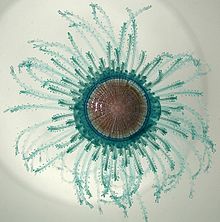Porpita: Difference between revisions
added hatnote |
ZKevinTheCat (talk | contribs) mNo edit summary |
||
| (20 intermediate revisions by 16 users not shown) | |||
| Line 1: | Line 1: | ||
{{Short description|Genus of hydrozoans}} |
|||
{{Redirect|Ratis|the Ancient Greek word|Raft}} |
|||
{{more footnotes|date=May 2019}} |
|||
{{Automatic taxobox |
{{Automatic taxobox |
||
| taxon = Porpita |
|||
| image = porpita porpita.jpg |
|||
| image_caption = [[Porpita porpita|Blue button]] (''Porpita porpita'') |
|||
| authority = Lamarck, 1801 |
| authority = Lamarck, 1801 |
||
| subdivision = {{species list |
| subdivision = {{species list |
||
| [[Porpita porpita]] | |
| ''[[Porpita porpita]]'' | |
||
| [[Porpita prunella]] |
| ''[[Porpita prunella]]'' |
||
}} |
}} |
||
| synonyms = |
| synonyms = |
||
| Line 15: | Line 19: | ||
* ''Discomitra'' <small>Haeckel, 1888</small> |
* ''Discomitra'' <small>Haeckel, 1888</small> |
||
* ''Disconalia'' <small>Haeckel, 1888</small> |
* ''Disconalia'' <small>Haeckel, 1888</small> |
||
* ''Polybrachionia'' <small>Guilding, 1828</small> |
|||
* ''Porpalia'' <small>Haeckel, 1888</small> |
* ''Porpalia'' <small>Haeckel, 1888</small> |
||
* ''Porpema'' <small>Haeckel, 1888</small> |
* ''Porpema'' <small>Haeckel, 1888</small> |
||
| Line 21: | Line 24: | ||
{{hidden end}} |
{{hidden end}} |
||
}} |
}} |
||
| ⚫ | '''''Porpita''''' is genus of [[hydrozoa]]ns in the family Porpitidae. It has two species recognized and is the [[type genus]] of its [[Family (biology)|family]].<ref>{{Cite web|url=http://www.marinespecies.org/aphia.php?p=taxdetails&id=117199|title=WoRMS - World Register of Marine Species - Porpita Lamarck, 1801|website=www.marinespecies.org|language=en|access-date=2018-02-19}}</ref> |
||
Porpita is also in the phylum Cnidarian. Similar to the well-known Portuguese Man-of-War, species in this genus consist mainly of colonies of hydrozoans, linked to a biological float, keeping them near the surface. Unlike the Man-of-War, however, the porpita lacks a sail and therefore does not get blown ashore as often.<ref> Meinkoch, Norman. "The Audubon Field Guide to North American Seashore Creatures." 1981. New York, New York. </ref> |
|||
| ⚫ | '''''Porpita''''' is genus of [[ |
||
<ref>{{Cite web|url=http://www.beachhunter.net/thingstoknow/jellyfish/blue-button-jellyfish.htm|title = Blue Button Jellyfish (Porpita porpita) blue jellyfish with fringe}}</ref> |
|||
Organisms from this genus reside in tropical to sub-tropical waters all around the world. Like other cnidarians, organisms from this genus possess stinging cells called [[Cnidocyte|cnidoblasts]]. The most common species of this genus is the ''Porpita porpita'', more commonly known as the "Blue Button Jellyfish." Often washing up on the coast of Florida, these particular hydrozoans do not possess a significant sting. Beachgoers that have come across them often say the sting is very minimal, if noticeable at all. |
|||
==References== |
==References== |
||
{{ |
{{Reflist}} |
||
{{Taxonbar|from=Q3908545}} |
|||
| ⚫ | |||
| ⚫ | |||
| ⚫ | |||
| ⚫ | |||
{{ |
{{Anthoathecata-stub}} |
||
Latest revision as of 03:26, 25 September 2024
This article includes a list of general references, but it lacks sufficient corresponding inline citations. (May 2019) |
| Porpita | |
|---|---|

| |
| Blue button (Porpita porpita) | |
| Scientific classification | |
| Domain: | Eukaryota |
| Kingdom: | Animalia |
| Phylum: | Cnidaria |
| Class: | Hydrozoa |
| Order: | Anthoathecata |
| Family: | Porpitidae |
| Genus: | Porpita Lamarck, 1801 |
| Species | |
| Synonyms | |
|
List
| |
Porpita is genus of hydrozoans in the family Porpitidae. It has two species recognized and is the type genus of its family.[1]
Porpita is also in the phylum Cnidarian. Similar to the well-known Portuguese Man-of-War, species in this genus consist mainly of colonies of hydrozoans, linked to a biological float, keeping them near the surface. Unlike the Man-of-War, however, the porpita lacks a sail and therefore does not get blown ashore as often.[2] [3]
Organisms from this genus reside in tropical to sub-tropical waters all around the world. Like other cnidarians, organisms from this genus possess stinging cells called cnidoblasts. The most common species of this genus is the Porpita porpita, more commonly known as the "Blue Button Jellyfish." Often washing up on the coast of Florida, these particular hydrozoans do not possess a significant sting. Beachgoers that have come across them often say the sting is very minimal, if noticeable at all.
References
[edit]- ^ "WoRMS - World Register of Marine Species - Porpita Lamarck, 1801". www.marinespecies.org. Retrieved 2018-02-19.
- ^ Meinkoch, Norman. "The Audubon Field Guide to North American Seashore Creatures." 1981. New York, New York.
- ^ "Blue Button Jellyfish (Porpita porpita) blue jellyfish with fringe".

